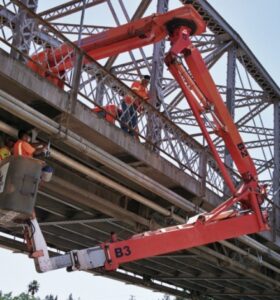When it comes to equipment used for bridge maintenance, repair, and inspections a number of terms are used to describe the same vehicle.
In this respect, bridge work is much like any other industry or field in that it has its own terms and terminology. However, to a newcomer or an outsider, some of these terms can be a bit confusing.
 When is a Boom Lift a Bucket Truck, or a Bucket Truck an Under Bridge Access Vehicle?
When is a Boom Lift a Bucket Truck, or a Bucket Truck an Under Bridge Access Vehicle?
Boom lifts, bucket trucks, aerial platforms… you can see why it can be a problem!
Perhaps a bit of an unofficial glossary is in order here. Since, strictly speaking, just about any vehicle or machine that supports a work platform at the end of a boom can be designated as an “aerial work platform” we can start there.
As one source defines it,
An aerial work platform (AWP), also known as an aerial device, elevating work platform (EWP), cherry picker, bucket truck or mobile elevating work platform (MEWP) is a mechanical device used to provide temporary access for people or equipment to inaccessible areas, usually at height. There are distinct types of mechanized access platforms and the individual types may also be known as a “cherry picker” or “scissor lift”.
In simple terms, an aerial work platform is a device that allows a worker or workers to access high or hard-to-reach locations. In many situations, the type of equipment used for this purpose is a basic boom lift.
The boom lift typically consists of a platform, or bucket, attached to the end of a long boom. This boom may be either telescoping or articulated, and in some cases both. The boom (or booms) is powered by a hydraulic lift system that is attached to a grounded base – a truck, trailer, or even a remotely operated base.
Most aerial work platforms, such as “bucket trucks”, are designed in one of two ways: as articulating booms or telescopic booms.
A typical articulating work platform has two or three boom sections that can “articulate” with a hinge structure that allows the operator to maneuver over or around barriers or obstacles. These machines can be quite versatile and they can place workers within reach of otherwise inaccessible areas.
The telescopic boom lifts have a simpler design with boom sections that only extend telescopically. Although they lack the accessibility of articulating booms, the telescopic boom lifts can often provide a far greater horizontal reach meaning they can go higher.
In addition, there are aerial work platforms known as scissor lifts.
Unlike other aerial work platforms, a scissor lift is essentially a mobile work scaffold that can be placed underneath a work area and then raised vertically. Scissor lifts are typically used indoors to access overhead lighting, HVAC components, and for painting or cleaning.
Here is a handy graphic that illustrates the five most common aerial work platforms:
(Graphic courtesy of Certifymeonline.net)
Under Bridge Access – When You Need to Go Out, Down, and Under – Not Up!
Generally speaking, bucket trucks, boom lifts, cherry pickers, and even SNOOPER™ trucks are all aerial lifts designed to go “up”.
But, when it comes to bridge work and bridge inspections, the overriding need is to go “down”.
Or, more accurately: over, out, down, and under. And possibly back and forth. It is these types of “aerial work platforms” or “boom lifts” that are what we know as “under bridge inspection units” or UBIUs.
And, like their cousins, they are designed in a variety of configurations.
The biggest under bridge inspection units are best suited for larger, wider bridges, while smaller bridge access equipment is used on narrower structures or for accessing vertical spaces below the bridge deck.
The major distinction that sets these units apart from other articulating boom lifts is that they are designed to be parked or mounted on a bridge deck where they then maneuver work platforms down and then under the bridge.
Another difference between UBIUs and ground-based aerial work platforms is the ability to access the underside of bridges that span waterways, active roadways, or railroad tracks.
And even if a bridge crosses over ground that is accessible, it may be too high above the ground to be reached with even the largest telescopic boom lifts.
Consider Under Bridge Platforms for Your Bridge Access Equipment Rentals
If your firm is involved with constructing new bridges, repairing or maintaining bridges, or just inspecting them, you need access to a variety of quality, professional equipment for your work. But most firms cannot buy and maintain a fleet of specialty vehicles and equipment just for bridge work.
Not to mention the means to insure and store them.
Which is why renting under bridge inspection units and other bridge equipment is the best way to have the right equipment when you need it.
Depending on how much bridge work your company does, you may have periods when only one under bridge inspection unit or access equipment is needed. At other times, however, you may have several bridge jobs working simultaneously. These are both scenarios where it is far more cost-effective to simply rent the right equipment when you need it – and only when you need it.
At Under Bridge Platforms, we provide quality under bridge equipment throughout all the Western States, including Utah, California, Nevada, Washington, and Oregon. Our inventory of boom lift trucks and under bridge inspection units includes many versatile and high-capacity vehicles, such as the reliable Skyjack SJB-66TK and the nimble Aspen Aerials A-30.
We take a great deal of pride in being the only company in California that offers total under bridge access. By offering high quality customer service, we have managed to build long-lasting relationships with our esteemed customers. And we intend to keep it that way.
Contact us today to discuss the specific needs of your project.

Recent Comments